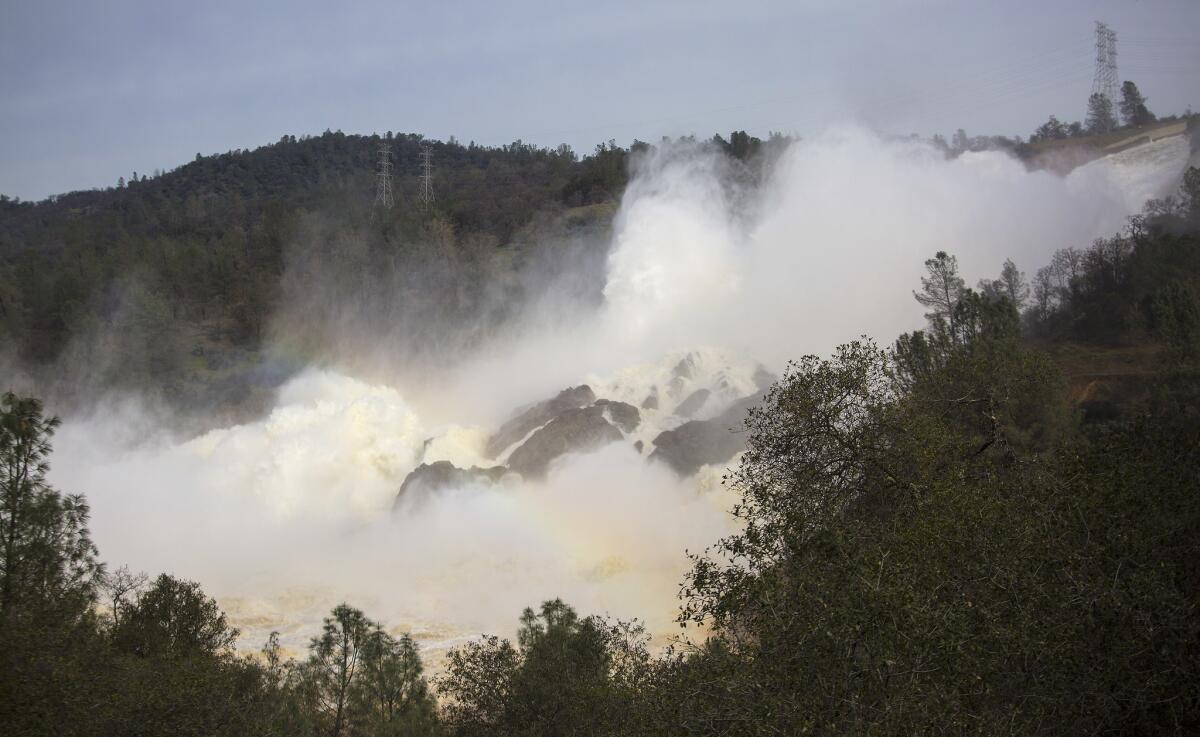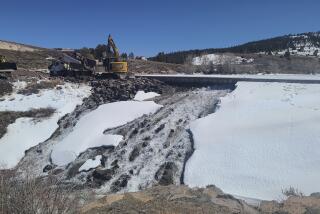Rain runoff may have undermined Oroville Dam’s concrete spillway, report says

Rainwater erosion alongside the Oroville Dam’s main spillway appears to have contributed to the heavy damage that prompted a crisis, forcing more than 100,000 to be evacuated from their homes, a report reviewed by The Times showed.
A summary of the incident, prepared by state water officials four days after the crater in the concrete chute appeared, said water from heavy rains hit the hillsides where the massive concrete spillway runs.
Flowing water during heavy rains was “diverted ... effectively eroding and undermining the spillway, causing a section to collapse,” said the incident summary.
The report offers the first indication from officials of what might have caused the catastrophic failure of the spillway. It’s unclear whether the rainwater was a primary reason for the spillway damage or one of many.
The spillway follows the slope of a dirt- and tree-covered hill that helps secure the towering dam, which is America’s tallest. The spillway fracture began as a 200-foot-wide hole that was 35 feet deep, but over the last week it has gotten significantly worse. Photographs of the initial damage show soil washed away beneath the sidewall of the concrete spillway and along its outer edge.
The damage to the spillway began a chain of events that led to the mass evacuations. Officials shut off releases to the spillway to investigate, and that caused water levels at Lake Oroville to rise. Then a storm dumped more rain than expected, causing the lake to exceed its limits and push water down an unpaved emergency spillway.
On Sunday, officials detected encroaching gullies that threatened that emergency spillway and, fearing that it could collapse, ordered numerous communities downstream to evacuate. Since then, officials have been using the damaged main spillway to lower the level of the reservoir, easing the crisis.
As storm moves in, engineers reduce outflow from Lake Oroville to clean up debris »
The state Department of Water Resources has provided no public statements on the cause of the collapse. Agency spokesman Chris Orrock, at the incident command post in Oroville on Thursday morning, said the cause remained under investigation. Orrock confirmed that the incident summary refers to the initial damage and not to subsequent damage to the concrete spillway that occurred when it was put back into use.
Bill Croyle, acting director of the Department of Water Resources, said determining the cause of the spillway collapse could take months.
Officials have estimated that fixing the spillway could cost $200 million or more. Because the spillway has been used to reduce the water levels at the reservoir, officials said they still need to assess the level of damage.
Records show the same section of spillway was repaired in 2013 but do not provide details.
Large swaths of Northern California are on track to experience their wettest winter on record, with many areas having already surpassed their average precipitation for an entire year. A new series of storms is set to hit the Oroville area over the next few days. But officials are confident they’ve drained the reservoir enough that the rains won’t overwhelm it a second time.
With the reservoir’s water level down more than 30 feet since Sunday and getting lower, Croyle said at a news conference Thursday that engineers will slow releases down the Oroville Dam’s damaged main spillway from 100,000 cubic feet of water per second to 80,000 cubic feet per second over a period of several hours.
The reduction will allow crews to move into the concrete channel to clear out trees, branches and other debris that has clogged the spillway and forced the downstream hydroelectric plant to go offline, Croyle said.
There was no estimate on when the power plant would be back up and running, but it will probably not be before Monday, he said.
Meanwhile, the herculean effort to reinforce the emergency spillway before more rain arrives used a caravan of helicopters and trucks to fill three deep fissures in the dirt hillside with rocks and cement.
As of Thursday, repairs on one erosion site were completed, the second was 25% filled and the third was 69% filled, Croyle said.
As long as the lake doesn’t reach capacity, Croyle said, the emergency spillway won’t be used.
The incoming storm system is weaker than the one that overwhelmed the lake last week after the dam’s main spillway eroded to the point of fracture, Croyle said.
Times staff writer Veronica Rocha contributed to this report.
St. John reported from Oroville, Serna from Los Angeles.
Follow us on Twitter at @paigestjohn and @JosephSerna
ALSO
Robert Durst confessed to killing Susan Berman, ‘secret witness’ says in court
Ex-Palm Springs mayor and 2 developers charged with corruption involving $375,000 in bribes
‘It’s going to be a mess’: Southern California braces for worst storm in years
UPDATES:
7:30 p.m.: This story was updated with background and more details about the situation at the Oroville Dam.
This story was originally published at 4:10 p.m.
More to Read
Start your day right
Sign up for Essential California for news, features and recommendations from the L.A. Times and beyond in your inbox six days a week.
You may occasionally receive promotional content from the Los Angeles Times.








